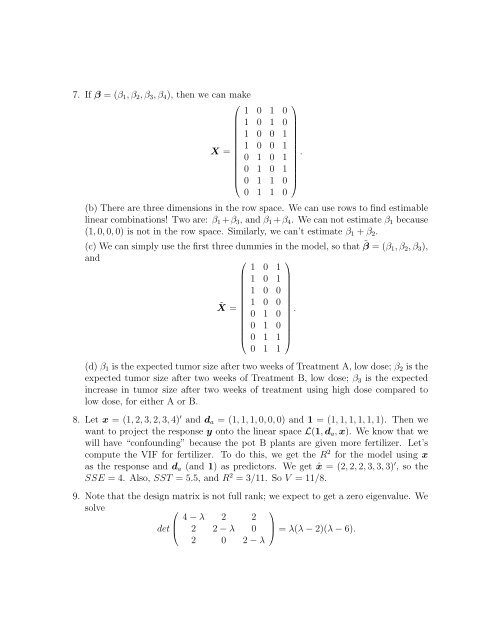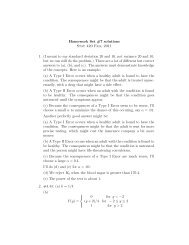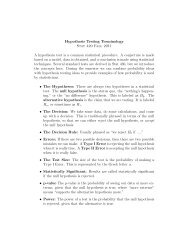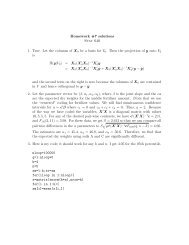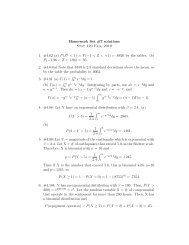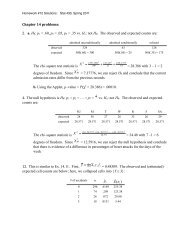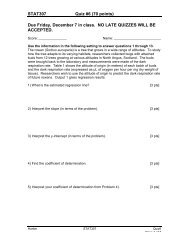Answers to Homework #5 - Statistics
Answers to Homework #5 - Statistics
Answers to Homework #5 - Statistics
You also want an ePaper? Increase the reach of your titles
YUMPU automatically turns print PDFs into web optimized ePapers that Google loves.
7. If β = (β 1 , β 2 , β 3 , β 4 ), then we can make<br />
⎛<br />
⎞<br />
1 0 1 0<br />
1 0 1 0<br />
1 0 0 1<br />
1 0 0 1<br />
X =<br />
.<br />
0 1 0 1<br />
0 1 0 1<br />
⎜<br />
⎟<br />
⎝ 0 1 1 0 ⎠<br />
0 1 1 0<br />
(b) There are three dimensions in the row space. We can use rows <strong>to</strong> find estimable<br />
linear combinations! Two are: β 1 +β 3 , and β 1 +β 4 . We can not estimate β 1 because<br />
(1, 0, 0, 0) is not in the row space. Similarly, we can’t estimate β 1 + β 2 .<br />
(c) We can simply use the first three dummies in the model, so that ˜β = (β 1 , β 2 , β 3 ),<br />
and<br />
⎛ ⎞<br />
1 0 1<br />
1 0 1<br />
1 0 0<br />
1 0 0<br />
˜X =<br />
.<br />
0 1 0<br />
0 1 0<br />
⎜ ⎟<br />
⎝ 0 1 1 ⎠<br />
0 1 1<br />
(d) β 1 is the expected tumor size after two weeks of Treatment A, low dose; β 2 is the<br />
expected tumor size after two weeks of Treatment B, low dose; β 3 is the expected<br />
increase in tumor size after two weeks of treatment using high dose compared <strong>to</strong><br />
low dose, for either A or B.<br />
8. Let x = (1, 2, 3, 2, 3, 4) ′ and d a = (1, 1, 1, 0, 0, 0) and 1 = (1, 1, 1, 1, 1, 1). Then we<br />
want <strong>to</strong> project the response y on<strong>to</strong> the linear space L(1, d a , x). We know that we<br />
will have “confounding” because the pot B plants are given more fertilizer. Let’s<br />
compute the VIF for fertilizer. To do this, we get the R 2 for the model using x<br />
as the response and d a (and 1) as predic<strong>to</strong>rs. We get ˆx = (2, 2, 2, 3, 3, 3) ′ , so the<br />
SSE = 4. Also, SST = 5.5, and R 2 = 3/11. So V = 11/8.<br />
9. Note that the design matrix is not full rank; we expect <strong>to</strong> get a zero eigenvalue. We<br />
solve<br />
⎛<br />
⎞<br />
4 − λ 2 2<br />
⎜<br />
⎟<br />
det ⎝ 2 2 − λ 0 ⎠ = λ(λ − 2)(λ − 6).<br />
2 0 2 − λ


